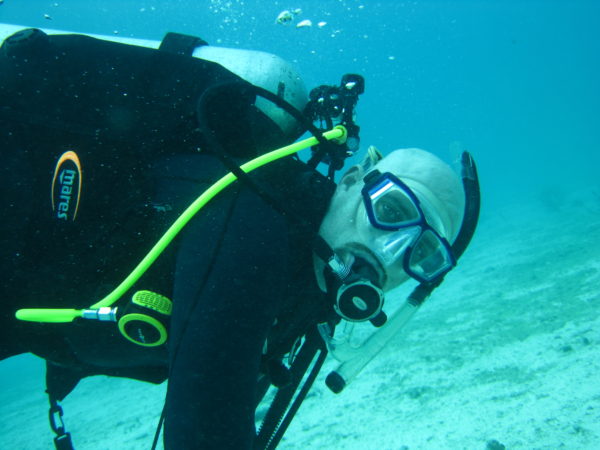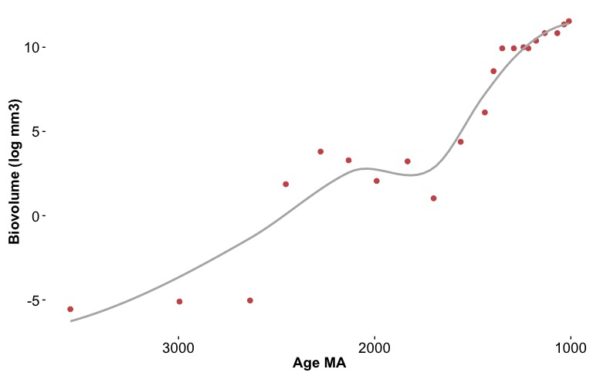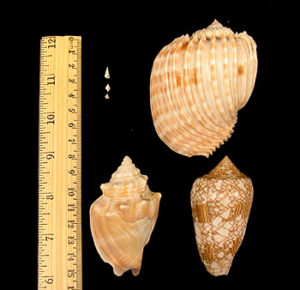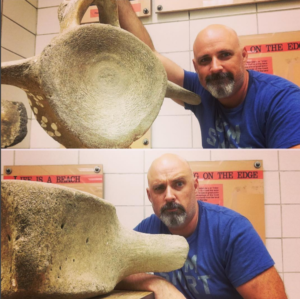The post I’m the modern day equivalent of a massive Carboniferous dragonfly first appeared on Deep Sea News.
]]> I am annoyingly the first one to return to the surface after any scuba dive. My bottom time exploring the wonders of the aquatic realm is 60-75% shorter than these friends. I know this specifically because I have kept detailed records in my dive logs. One of my closest friends, using the same size scuba tank as I, can return to the surface after me and then use the remaining air in his tank to complete an entire second dive. I hate him. No but really, it’s very annoying. The difference between him and I? Primarily our size. At 6’3’’ and 250 lbs., depending on the proximity to the holiday season, I am by most definitions a “big guy”. My friend is closer to 5’3’’ and weighs of course considerably less. Tanks of air for scuba diving come in different sizes denote by the holding capacity measured in pressurized cubic feet. Most recreational divers find that an 80 to 100-cubic-foot tank is sufficient for their underwater breathing needs. My friend dives with a tank in the 70 range. I cannot match his time with 110-cubic-foot tank.
I am annoyingly the first one to return to the surface after any scuba dive. My bottom time exploring the wonders of the aquatic realm is 60-75% shorter than these friends. I know this specifically because I have kept detailed records in my dive logs. One of my closest friends, using the same size scuba tank as I, can return to the surface after me and then use the remaining air in his tank to complete an entire second dive. I hate him. No but really, it’s very annoying. The difference between him and I? Primarily our size. At 6’3’’ and 250 lbs., depending on the proximity to the holiday season, I am by most definitions a “big guy”. My friend is closer to 5’3’’ and weighs of course considerably less. Tanks of air for scuba diving come in different sizes denote by the holding capacity measured in pressurized cubic feet. Most recreational divers find that an 80 to 100-cubic-foot tank is sufficient for their underwater breathing needs. My friend dives with a tank in the 70 range. I cannot match his time with 110-cubic-foot tank.

I am reminded that with great repetition, scientists have found in areas of land and ocean with more oxygen, animals are larger. In 2001, my Ph.D. advisor Mike Rex and I found that snails in the deep ocean were much larger in parts of the abyss where oxygen was higher. In one species, one of my favorite deep-sea snails (yes I have a favorite deep-sea snail) Benthomangelia antonia, size doubled across the Atlantic Ocean due to a relatively small increase in oxygen concentration. A couple of years earlier, the duo of Chapelle and Peck compared 1,853 species of amphipods crustaceans from the poles to equator in both marine and freshwater areas. They too found when there was more oxygen animals were bigger. Alligators, fruit flies, domestic chickens, trout, rats, red-bellied turtles, mealworms, and garter snakes, when grown in low oxygen environments obtain smaller sizes. Even humans living in lower oxygen concentrations at higher elevations, as seen in the high altitude dwelling Peruvians and Tibetans, reach smaller adult sizes.
This pattern of large animals in higher oxygen regions and vice versa also translates across the history of life as well. Animals were larger during geologic times when oxygen concentrations were greater. Enter the massive dragonflies of the genus Meganeura that occurred during the Carboniferous, approximately 300 million years ago. With wingspans of up to 65 centimeters (25.6 inches), Meganeura was one of the larges known flying insects to have lived on Earth. Their existence and large sizes occurs during a time with atmospheric oxygen was at high. This high oxygen era led to a lot more than just large dragonflies. The land and oceans were teeming with giants ranging from arthropods, bryozoans, urchins, brachiopods, and corals. Moreover, the sizes of the largest arthropods, mollusks, and chordates all decline from the Carboniferous to the lower oxygen Permian.
 In 2009, my friend and colleague Jon Payne at Stanford university lead a team (myself included) documenting changes in the maximum size of life throughout the history of life (see above plot). During this 3.5 billion year span, life increased over 16 orders of magnitude in body size. However, a great majority of this increase occurred in two discrete steps one at 1.9 billion years ago and the second approximately 0.5 billion years. The steps corresponded with evolution from prokaryotic to eukaryotic cells and from single cell to multicelluar organisms. Most interestingly, these steps also coincide, or slightly postdate, major increase of oxygen in the atmosphere. Major shifts in size and the complexity of life appears to have required more oxygen.
In 2009, my friend and colleague Jon Payne at Stanford university lead a team (myself included) documenting changes in the maximum size of life throughout the history of life (see above plot). During this 3.5 billion year span, life increased over 16 orders of magnitude in body size. However, a great majority of this increase occurred in two discrete steps one at 1.9 billion years ago and the second approximately 0.5 billion years. The steps corresponded with evolution from prokaryotic to eukaryotic cells and from single cell to multicelluar organisms. Most interestingly, these steps also coincide, or slightly postdate, major increase of oxygen in the atmosphere. Major shifts in size and the complexity of life appears to have required more oxygen.
But why this pattern? Simply, cells require oxygen to make cellular energy in the form of ATP. The more cells that come with bigger body sizes require even larger quantities of oxygen. But the whole story is more complicated than just this. Oxygen uptake by an organism is limited by the amount of surface area available for diffusion whether it be the surface area of the gills, lungs, or body surface. But how much oxygen an organism needs is governed by its mass. With increasing size, mass increases quicker than surface area, thus demand increases more quickly than supply. For any given shape there will be a critical size in which oxygen cannot supply demand. This constraint is exacerbated by low oxygen concentrations. This is also why gills and lungs have evolved to increase their surface areas through branching, invagination, and folding.
Despite my continued frustration with this whole scuba scenario, I try to remember I am simply the modern day equivalent of the massive dragonflies of the Carboniferous. We are creatures bound by physics and biology.
The post I’m the modern day equivalent of a massive Carboniferous dragonfly first appeared on Deep Sea News.
]]>The post Craig With Big Things (and Small Things) first appeared on Deep Sea News.
]]>
 I am not sure when this obsession with both small and large things began. One of the earliest photographs of me is in a giant rocking chair. With a big smile on my face, I am dwarfed by the colossal piece of furniture. Sadly, in researching this post I discovered this rocking chair is not the largest. That title is bestowed to a towering rocking chair, a 56.5 feet tall behemoth in Casey, Illinois, not only the world’s largest rocking chair but also the largest chair in all of America. I will of course need to visit, and photograph, myself next to the massive chair. Another photograph to add to my photo collection of myself with oversized objects. The world’s largest Adirondack chair and me…got it. Largest chest of drawers…done. Largest frying pan…visited. Giant 6-foot tall cheese grater…photographed and almost bought. I could go on and on.
I am not sure when this obsession with both small and large things began. One of the earliest photographs of me is in a giant rocking chair. With a big smile on my face, I am dwarfed by the colossal piece of furniture. Sadly, in researching this post I discovered this rocking chair is not the largest. That title is bestowed to a towering rocking chair, a 56.5 feet tall behemoth in Casey, Illinois, not only the world’s largest rocking chair but also the largest chair in all of America. I will of course need to visit, and photograph, myself next to the massive chair. Another photograph to add to my photo collection of myself with oversized objects. The world’s largest Adirondack chair and me…got it. Largest chest of drawers…done. Largest frying pan…visited. Giant 6-foot tall cheese grater…photographed and almost bought. I could go on and on.
 I never realized I could get paid for my obsession. I did not at some point in high school realize or declare I wanted a vocation focused on extreme sizes. Nor was such a trajectory flagged as a possibility on those mandated vocational tests. I got flagged for being perfect for cake decorating. No joke. Nothing about decorating tiny or giant cakes. Of course, who would even think you could make a career out of a passion for size, except maybe Guinness World Records? No, I came by it all by accident.
I never realized I could get paid for my obsession. I did not at some point in high school realize or declare I wanted a vocation focused on extreme sizes. Nor was such a trajectory flagged as a possibility on those mandated vocational tests. I got flagged for being perfect for cake decorating. No joke. Nothing about decorating tiny or giant cakes. Of course, who would even think you could make a career out of a passion for size, except maybe Guinness World Records? No, I came by it all by accident.
As an undergraduate, I applied for a summer program to conduct research with a biologist. Knowing at the time I wanted to be a marine biologist, I applied to do summer research counting fish on the coral reefs of St. Croix. An unshockingly, popular choice among undergraduates, I did not get the position. My second and third choices were the only other ocean-based projects in the program. When the scientist involved with my second choice project called to invite me to work with him that summer, I didn’t even remember what the project was. I wasn’t really concerned with the specifics of the other projects because how could I not be selected for my first choice, St. Croix, dream project. Opposed to the beautiful tropical beaches of the Caribbean, my destiny would be to work in a windowless lab all summer in Boston. The project didn’t exceedingly interest me at the time as I wanted to be a field scientist and microscopy in the lab sounded…well dull. But working in an air-conditioned lab in the big city sounded better than living with my parents in rural Arkansas working in the intense Southern heat sweating in a factory. So off to Boston I went. Within a few hours of the first day, I fell in love with the project. So much so I asked that scientist, a preeminent deep-sea biologist and expert on the body size of marine invertebrates, if I could pursue a doctorate with him.
In the biological world, size is more than a novelty. How an organism relates to the world around it is determined by its size, and understanding what influences size is key to understanding the diversity of life itself. That summer I measured the size of 100’s of tiny snails and when I returned to pursue my Ph.D. I measured thousands more. In total I measured 14,278 deep-sea snails. The largest no bigger than Abraham Lincoln’s head on the face of the penny. The smallest the size of his nose. Those snails I measured were collected from off the coast of New England from depths of over 600 feet to well over 18,000 feet, from the shallows of the New England continental shelf to the abyssal plains.

Why would anyone measure close to 15,000 snails? In the late 1800’s Henry Nottidge Mosely wrote: “Some animals appear to be dwarfed by deep- sea conditions.” By the 1970s, Hjalmar Thiel of Universität Hamburg observed that the deep sea is a “small organism habitat.” Increased depth typically translates into less food in the oceans with the deep-sea being a very food poor environment. As you might expect this has profound effects on the body size of deep-sea animals. Thiel’s seminal 1975 work demonstrated that with increased depth, smaller organisms became more dominant. At depths greater than 4 kilometers on the vast abyssal plains where food is extremely limited, you find some of the most diminutive sizes. In a particularly striking example of this, my doctoral advisor Michael Rex and I calculated those nearly 15,000 deep-sea snails I measured could fit completely inside a single Busycon carica, a fist-sized New England knobbed whelk found along the coast. But by measuring all those snails, Mike and I were able to document exactly how size in these snails changes over a 3.5 mile increase in depth. That study was the first of its kind and remains the largest number of deep-sea animals ever individually measured.
But to say that all creatures of the deep are miniaturized overlooks the complexity of size evolution in the deep sea. Some taxa actually become giants. The Giant Isopod, a roly-poly the size of very large men’s shoe, and sea-spiders the size of dinner plates, quickly dispel the Lilliputian view of the deep sea. Although all those deep-sea snails are smaller than their shallow-water relatives, shockingly Mike and I also found that they actually increase in size with greater depth and presumed lower food availability. To further confound the situation, other scientists have reported the exact opposite pattern in other types of snails, whose size decreases with depth. The same appeared to be true in other taxa, such as crustaceans. How can the deep-sea be both a habitat of dwarfs and giants?
To answer that, I turned from the Earth’s largest habitat to one of its smallest—islands. On islands both giants and dwarfs exist. The diminished kiwi and the enormous Moa of New Zealand, the colossal Komodo dragon on the island of Komodo, the extinct pygmy elephants on the islands of the Mediterranean, the ant-sized frog of the Seychelles, the giant hissing cockroach of Madagascar and the giant tortoise of the Galapagos represent just a few of the multitudes of size extremes on islands. In 1964, J. Bristol Foster of the University of East Africa demonstrated that large mammals became miniaturized over time on islands. Conversely, small mammals tended toward gigantism. This occurs with such frequency that scientists refer to it as “Foster’s rule” or the “Island rule.” Big animals getting small and small animals getting large.
My colleagues and I discovered a similar pattern in 2006 between shallow and deep seas. As shallow-water gastropods evolved into deep-sea dwellers, small species became larger and large species became smaller. Interestingly, size did not shift in a parallel manner. Larger taxa became disproportionately smaller sized—that is, both converged on a size somewhat smaller than medium. I’ve since observed this pattern in radically different taxa, such as bivalves, sharks, and cephalopods.
The fact that islands and the deep sea have so little in common represents a wonderful opportunity that allows elimination of several hypotheses. Of course, what the deep sea lacks is food. The absence of sunlight precludes plants. Thus, for the majority of organisms living there, the food chain starts with plankton, dead organisms and other organic debris descending from the ocean’s surface. Less than five per cent of the total food available drifts to the sea floor, leading to an extremely food-limited environment. On islands, less food is available because the small land areas support fewer plants at the base of the food chain.
 In either case, island and deep-sea animals need to be efficient and creative in their acquisition of food. In both habitats, there may not be enough total food to support populations of giants only. Unable to travel long distances to search for food or to store large fat reserves to fast through periods of food scarcity, smaller organisms are also at a disadvantage. If these contrasting evolutionary pressures were equal, size would be driven to an intermediate. However, the selection against larger sizes is greater, leading toward an evolutionary convergence that is slightly smaller than the intermediate size. Thus, differential responses to food reduction by different- sized organisms may resolve the outstanding paradox of divergent size patterns in the deep. In the interests of reaching this ‘golden medium’, some species become giant while others miniaturized.
In either case, island and deep-sea animals need to be efficient and creative in their acquisition of food. In both habitats, there may not be enough total food to support populations of giants only. Unable to travel long distances to search for food or to store large fat reserves to fast through periods of food scarcity, smaller organisms are also at a disadvantage. If these contrasting evolutionary pressures were equal, size would be driven to an intermediate. However, the selection against larger sizes is greater, leading toward an evolutionary convergence that is slightly smaller than the intermediate size. Thus, differential responses to food reduction by different- sized organisms may resolve the outstanding paradox of divergent size patterns in the deep. In the interests of reaching this ‘golden medium’, some species become giant while others miniaturized.
In that summer of 1996, as a clueless undergraduate, I started my scientific adventure that fueled my obsession with size. Two decades later, I still am excited by the body size of animals. Much of my research, and the students who work with me, is dedicated to understanding how the expansive variety of sizes on Earth from bacteria to blue whales emerged. Did I mention the great selfie I took recently with a giant whale vertebra the size of coffee table?
The post Craig With Big Things (and Small Things) first appeared on Deep Sea News.
]]>The post Why is The Giant Isopod Giant? first appeared on Deep Sea News.
]]>
Kevin’s wonderful post on the Giant Isopod inspired me to post on a topic I have long pondered. Frequent readers of DSN know that I am fond of Sylvia Earle and the topic of body size. Honestly, it is not just body size is all matter of size related issues. A roadside trip can be quickly diverted by the world’s largest ball of yarn or North America’s largest biscuit. Mmm…biscuits, but I digress. What I want to discuss, and I use this word specifically as after 10 years contemplation I seem no closer to an answer, is why the Giant Isopod is, well, giant?
Mosely noted in 1880
Other [animals] attain under them gigantic proportions. It is especially certain crustacea which exhibit this latter peculiarity, but not all crustacea, for the crayfish like forms in the deep sea are of ordinary size. I have already referred to a gigantic Pycnogonid [sea spider] dredged by us. Mr. Agassiz dredged a gigantic Isopod eleven inches in length. We also dredged a gigantic Ostracod.
For over a 125 years, scientists have contemplated the extreme size of Bathynomus giganteus. Do other isopods attain these sizes? Gigantism is also known in the isopod Serolis but enlargement comes from flattening that increases the effective surface area. B. giganteus appears unique in its extreme gain in bulk.
Why the increase in size? Timofeev (2001) proposed that deep-sea gigantism, for all crustaceans, is a consequence of larger cells sizes obtained under cold temperatures, as has proposed for other groups (e.g. Van Voorhies 1996). In crustaceans, bathymetric gigantism may also in part reflect decreases in temperature leading to longer lifespans and thus larger sizes in indeterminate growers (Timofeev 2001). However, despite little changes in temperature beyond the thermocline, deep-sea invertebrates including isopods continue to show changes in body size. Alternatively, Chapelle and Peck (1999 and 2004) demonstrated that maximum potential size was significantly correlated with oxygen concentration in the related amphipods. It is suggested this relationship arises because the amount of oxygen available controls the amount of sustainable tissue. This has been shown experimentally in which cell size and cell number both increase with increasing oxygen concentration (Frazier et al. 2001, Peck and Chapelle 2003). Larger sizes in gastropods are also found at more oxygenated sites in the deep sea (McClain and Rex 2001). However, giant isopods are known from the Gulf of Mexico deep where oxygen concentrations are low.
Kevin also brought up another interesting point….
B. giganteus is a scavenger (3, 5, 6), but some suggest it is also a facultative predator (3, 6). Specimens in aquaria have survived 8 weeks between feedings (5) and it speculated that this may be an adaptation for carrying its brood, which would be severely impacted by a full stomach (3). Further support for this hypothesis are the large quantities of lipid reserves in the hepatopancreas (14) and fat bodies (2) of this isopod.
Alternatively, the larger size also increases fasting potential because greater fat reserves can be maintained. Larger size also confers a greater foraging area, important for either a scavenger or a predator. Both of these are important adaptations in the food-limited deep sea.
Of course all of this is speculative and it remains unclear why Bathynomus is unique among arthropods. Perhaps is size is simply a random walk in evolution and is nonadaptive. Gould noted in reference to another body size pattern, Cope’s Rule…
One would think that issues so fundamental, and so eminently testable, had been conclusively resolved long ago-except for a perverse trait of human psyche. We tend to pick most ‘notable’ cases out of general pools, often for idiosyncratic reasons that can only distort a proper scientific investigation
Is this case for the Giant Isopod? But perhaps the most interesting question is why the Giant Isopod is not larger?
The post Why is The Giant Isopod Giant? first appeared on Deep Sea News.
]]>The post Giant Denizens of the Deep are Molluscs! first appeared on Deep Sea News.
]]> You can see the new capture follows slightly below the average. Molluscs (clams, oysters, scallops, chitons, tusk shells, squid, octopods, nautilus, snails, slugs) are fascinating group in general with respect to body size. Body sizes vary over 12 orders of magnitude in volume from the smallest gastropods (snails and slugs; such as <0.2 mm3 Carychium nannodes, a terrestrial land snail, from North America) to the largest cephalopods (ca. 2.2 x 1011 m3 for the giant squid Architeuthis dux). Why the remarkable range in size?
You can see the new capture follows slightly below the average. Molluscs (clams, oysters, scallops, chitons, tusk shells, squid, octopods, nautilus, snails, slugs) are fascinating group in general with respect to body size. Body sizes vary over 12 orders of magnitude in volume from the smallest gastropods (snails and slugs; such as <0.2 mm3 Carychium nannodes, a terrestrial land snail, from North America) to the largest cephalopods (ca. 2.2 x 1011 m3 for the giant squid Architeuthis dux). Why the remarkable range in size?
As noted by Barnes et al. (1993) “Their success is probably not so much attributable to any particular special anatomical or ecological features of the group as to the extreme plasticity and adaptability of the basic molluscan body plan.” As an example to this consider, the radiation of the mollusca includes the obvious addition of an exoskeleton but also subsequent major modifications by coiling, reduction, duplication, segmentation, and in multiple independent events the ultimate loss of the shell. The phylum possesses groups with specialized neural systems and two fundamentally different respiratory systems. Most feeding styles are known from within the group, including parasitism and symbiotic mutualisms (including coral reef zooxanthellae and hydrothermal vent chemosynthetic bacteria). Reproductive biology varies from sexual dimorphism to hermaphrodism, with uniparental mating being common in some species.
text from McClain and Nekola in press
The post Giant Denizens of the Deep are Molluscs! first appeared on Deep Sea News.
]]>